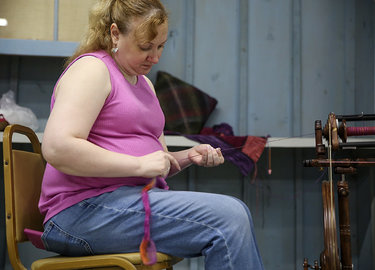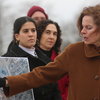The Wool Nook celebrates the miracle of yarn creations, encourages others to learn
ALTAMONT — When Heather Rost was 15 years old, she helped at a sheep show at the annual Altamont Fair.
“I went home that night and said, ‘Mom, Dad, I love sheep,’” Rost recalled.
She wanted one.
Her parents, who had a small farm in Delanson, looked into it and the next spring purchased two lambs.
The Rosts went on to purchase a ram so Heather could breed her own sheep; the flock grew to 18.
“It spiraled from there,” said Rost, who is the superintendent of the Wool Nook at the annual tri-county fair in Altamont.
She showed the animals she raised and won in competitions for both the sheep and for their fleece, often competing at festivals with farms that had 200 to 300 sheep.
When she had a child of her own — Jarod is now 21 and studying finance at Siena College — he had his own ewe at age 8 and he still helps out at the fair.
A love of sheep runs in the family.
Heather’s mother and Jarod’s grandmother, Donna Rost, was the longtime superintendent of the sheep barn at the fair.
The Wool Nook is at one end of that barn.
Pat Canaday, a director emerita for the fair, “introduced me to the world of sheep,” said Rost.
“We had all this wool … We needed something to do with it,” she said.
Rost first learned to spin her wool into yarn and then she learned to knit from her mother.
“My world opened to fiber arts,” said Rost. “I got into doing weaving.” She has a floor loom and a table loom and also does continuous strand weaving.
“So I don’t have to worry about spending two days warping my loom and then start to do the weaving process,” she said.
Canaday, too, both weaves and knits.
“It’s almost a miracle,” said Canaday, describing the humble origins of human clothing made from animal skins. “Then people learned they could criss-cross threads.”
Canaday said, “Working fiber is very reflective.” Although she is geared towards being social, she said, especially in the winter, she enjoys weaving and knitting.
“There are hundreds and hundreds of years of connection,” she said.
Fair family
Rost said she didn’t hesitate when she was asked to supervise the Wool Nook.
“Of course I’m not going to say no to part of a family unit. It doesn’t matter if you show goats or sheep — you are a whole family. We go see our family once a year, with the family reunion,” Rost said of the August Fair Week.
Rost “learned the ropes” from the former superintendent who had health challenges.
Although Rost had entered her own creations in the competitions at the Wool Nook, she said she had to learn about the judging process.
She calls on a pool of local experts to judge but says, sadly, that pool is diminishing as fewer young people are taking up fiber arts.
The judging is closed so that the judges aren’t overwhelmed by people asking questions.
The judges comments can range from “Hey, awesome!” to pieces of sage advice for improvement.
Rost depends on contributors to put on up to five demonstrations every day the fair is open, this year from Aug. 13 to 18.
As the demonstrators spin or knit or felt or weave or crochet, they answer questions from the public. She values the creativity of the women, whom she likens to artists in any field.
“I have never worked with a better group of people,” said Rost. “Most of the exhibitors I know, but there are new ones that come in every year … and they are always asking questions and how to improve their stuff or what new craft they could take on.”
While Rost is racing to get everything ready for the fair that starts next week, at the same time she is also planning ahead for next year’s Altamont Fair.
Every year, the Wool Nook spotlights a single item; this year, it’s socks.
“We provided a pattern last fall,” Rost said. “It will be interesting to see what people come up with … the judge will pick the pair of socks that she feels best features the pattern that we chose.”
The women at the Wool Nook mentor each other as well as visitors. “The exhibitors range in age from teenagers all the way up to people in their sixties and seventies,” she said.
Rost laments that fewer young people are taking up fiber arts. “Hand arts in general are dying arts,” she said. “There’s times where people see me knitting and they’ll be like, ‘You’re so young.’ Well, I’m middle-aged, in my forties, but this is something I learned at 16 and I love it.
“I’m not going to stop doing it and I wish we could promote it more and get younger folks into it too.”
Reflecting on the benefits of hand crafts, Rost said, “You find a solitude, something you can let out your nerves on. It’s not like sitting in front of a TV or playing a video game or playing on your cell phone.”
She wishes more young people were like her son who knows how to spin yarn and to knit and weave. “He can help me find a stitch I dropped,” she said.
Rost went on, “The Wool Nook can play a huge role in teaching kids the history of their family. Their great-grandmother or grandmother could have been doing it and they had no clue what it was at the time because nobody took the time to explain it to them.”
Rost, who works for the state’s Taxation and Finance Department, describes it as “a high-speed job.” She finds that knitting grounds her.
“When I get off the phone and my head is spinning because I’ve been dealing with multiple facets of my department,” said Rost, “I can just pick up my knitting and focus on that …It’s neutral ground … I just calm down. I recenter myself so that I can go on with my day …
“It’s always been a source of peace for me. If I could show that to people and have them understand it, I think I would be a millionaire.”



